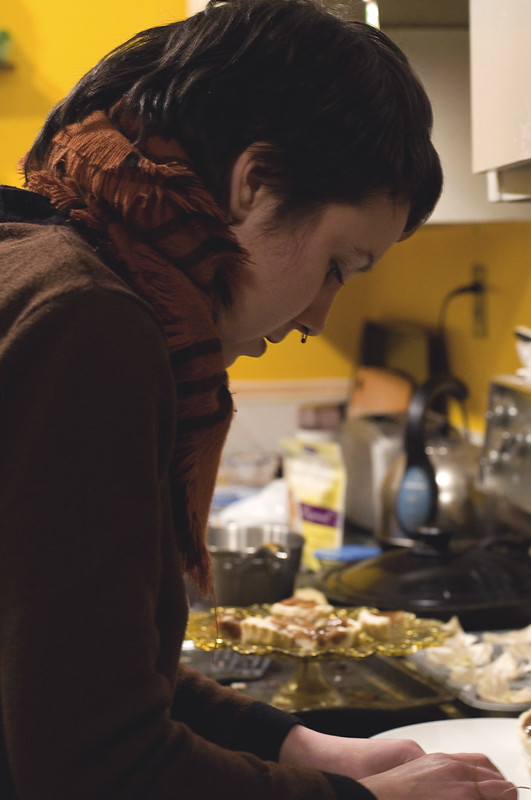
"can I take your picture?"
"do I have to stop playing Civilizations?"




 It seemed fitting to do a review of this just before the premiere of Season 2 of the show on HBO. I loved my recent foray into graphic novel adaptations of books (with Uglies: Shay’s Story) and A Game of Thrones is the perfect follow up to that. In this case it’s a book series that I’m just never going to be able to read – 800+ pages in book 1, 900+ pages in book 2 – I struggle to get through a 300-400 page novel in a few weeks. I’d spend half my year trying to read these two books alone. And the TV series didn’t really interest my wife, and since we’re usually watching together, there just hasn’t been much opportunity to me to see more than the first few episodes.
It seemed fitting to do a review of this just before the premiere of Season 2 of the show on HBO. I loved my recent foray into graphic novel adaptations of books (with Uglies: Shay’s Story) and A Game of Thrones is the perfect follow up to that. In this case it’s a book series that I’m just never going to be able to read – 800+ pages in book 1, 900+ pages in book 2 – I struggle to get through a 300-400 page novel in a few weeks. I’d spend half my year trying to read these two books alone. And the TV series didn’t really interest my wife, and since we’re usually watching together, there just hasn’t been much opportunity to me to see more than the first few episodes. It should come as no surprise that this adaptation has some differences from the HBO series, and those sometimes subtle differences are mostly for the better. Scenes are expanded or extra bits of dialog are included in this graphic novel that just helped me understand the story that much better. Daenerys marriage to Drogo isn’t quite as smooth at first as it’s portrayed in the TV show, though eventually they both get to the same place of peace. But because of the limitations of budget on TV and the lack thereof when drawing, here we get to see Daenerys visions of Dragons and a wickedly wonderful Iron Throne that just needs to be seen to be believed.
It should come as no surprise that this adaptation has some differences from the HBO series, and those sometimes subtle differences are mostly for the better. Scenes are expanded or extra bits of dialog are included in this graphic novel that just helped me understand the story that much better. Daenerys marriage to Drogo isn’t quite as smooth at first as it’s portrayed in the TV show, though eventually they both get to the same place of peace. But because of the limitations of budget on TV and the lack thereof when drawing, here we get to see Daenerys visions of Dragons and a wickedly wonderful Iron Throne that just needs to be seen to be believed. In all ways though, I was blown away by the artwork. I’ve never heard of Tommy Patterson before, but with a style very reminiscent of Michael Turner, I’ll be looking out for more work from him in the future. There is a substantive look at the making of this comic at the end of the book, which is a very worthwhile read. There were things I didn’t notice about the art until after reading this section – and it made me appreciate all the work going into the detailed backgrounds that the reader just takes for granted when reading the story. Most comics don’t look like this, and most artists aren’t drawing with this kind of attention to detail. It puts A Game of Thrones at a whole different level from everything else.
In all ways though, I was blown away by the artwork. I’ve never heard of Tommy Patterson before, but with a style very reminiscent of Michael Turner, I’ll be looking out for more work from him in the future. There is a substantive look at the making of this comic at the end of the book, which is a very worthwhile read. There were things I didn’t notice about the art until after reading this section – and it made me appreciate all the work going into the detailed backgrounds that the reader just takes for granted when reading the story. Most comics don’t look like this, and most artists aren’t drawing with this kind of attention to detail. It puts A Game of Thrones at a whole different level from everything else. It seemed fitting to do a review of this just before the premiere of Season 2 of the show on HBO. I loved my recent foray into graphic novel adaptations of books (with Uglies: Shay’s Story) and A Game of Thrones is the perfect follow up to that. In this case it’s a book series that I’m just never going to be able to read – 800+ pages in book 1, 900+ pages in book 2 – I struggle to get through a 300-400 page novel in a few weeks. I’d spend half my year trying to read these two books alone. And the TV series didn’t really interest my wife, and since we’re usually watching together, there just hasn’t been much opportunity to me to see more than the first few episodes.
It seemed fitting to do a review of this just before the premiere of Season 2 of the show on HBO. I loved my recent foray into graphic novel adaptations of books (with Uglies: Shay’s Story) and A Game of Thrones is the perfect follow up to that. In this case it’s a book series that I’m just never going to be able to read – 800+ pages in book 1, 900+ pages in book 2 – I struggle to get through a 300-400 page novel in a few weeks. I’d spend half my year trying to read these two books alone. And the TV series didn’t really interest my wife, and since we’re usually watching together, there just hasn’t been much opportunity to me to see more than the first few episodes. It should come as no surprise that this adaptation has some differences from the HBO series, and those sometimes subtle differences are mostly for the better. Scenes are expanded or extra bits of dialog are included in this graphic novel that just helped me understand the story that much better. Daenerys marriage to Drogo isn’t quite as smooth at first as it’s portrayed in the TV show, though eventually they both get to the same place of peace. But because of the limitations of budget on TV and the lack thereof when drawing, here we get to see Daenerys visions of Dragons and a wickedly wonderful Iron Throne that just needs to be seen to be believed.
It should come as no surprise that this adaptation has some differences from the HBO series, and those sometimes subtle differences are mostly for the better. Scenes are expanded or extra bits of dialog are included in this graphic novel that just helped me understand the story that much better. Daenerys marriage to Drogo isn’t quite as smooth at first as it’s portrayed in the TV show, though eventually they both get to the same place of peace. But because of the limitations of budget on TV and the lack thereof when drawing, here we get to see Daenerys visions of Dragons and a wickedly wonderful Iron Throne that just needs to be seen to be believed. In all ways though, I was blown away by the artwork. I’ve never heard of Tommy Patterson before, but with a style very reminiscent of Michael Turner, I’ll be looking out for more work from him in the future. There is a substantive look at the making of this comic at the end of the book, which is a very worthwhile read. There were things I didn’t notice about the art until after reading this section – and it made me appreciate all the work going into the detailed backgrounds that the reader just takes for granted when reading the story. Most comics don’t look like this, and most artists aren’t drawing with this kind of attention to detail. It puts A Game of Thrones at a whole different level from everything else.
In all ways though, I was blown away by the artwork. I’ve never heard of Tommy Patterson before, but with a style very reminiscent of Michael Turner, I’ll be looking out for more work from him in the future. There is a substantive look at the making of this comic at the end of the book, which is a very worthwhile read. There were things I didn’t notice about the art until after reading this section – and it made me appreciate all the work going into the detailed backgrounds that the reader just takes for granted when reading the story. Most comics don’t look like this, and most artists aren’t drawing with this kind of attention to detail. It puts A Game of Thrones at a whole different level from everything else. Hush by James Maxey
Hush by James Maxey Hush by James Maxey
Hush by James Maxey